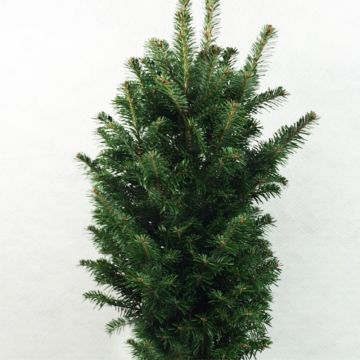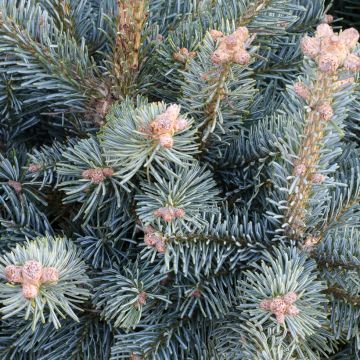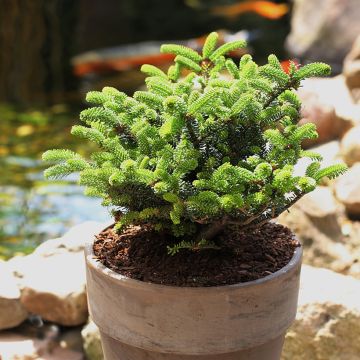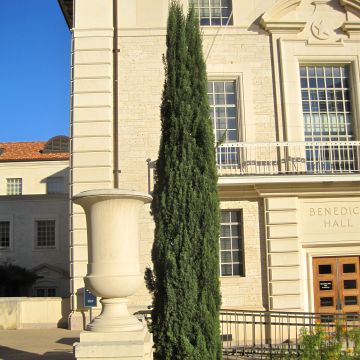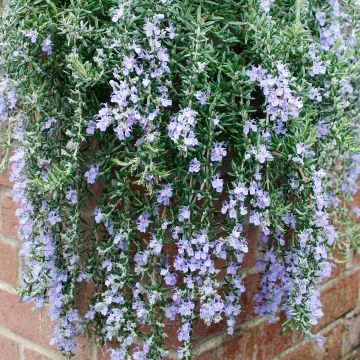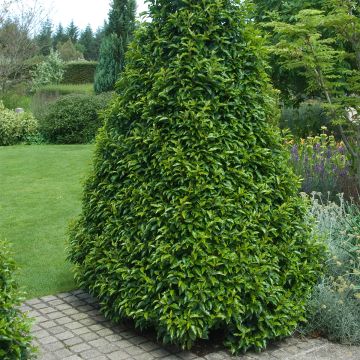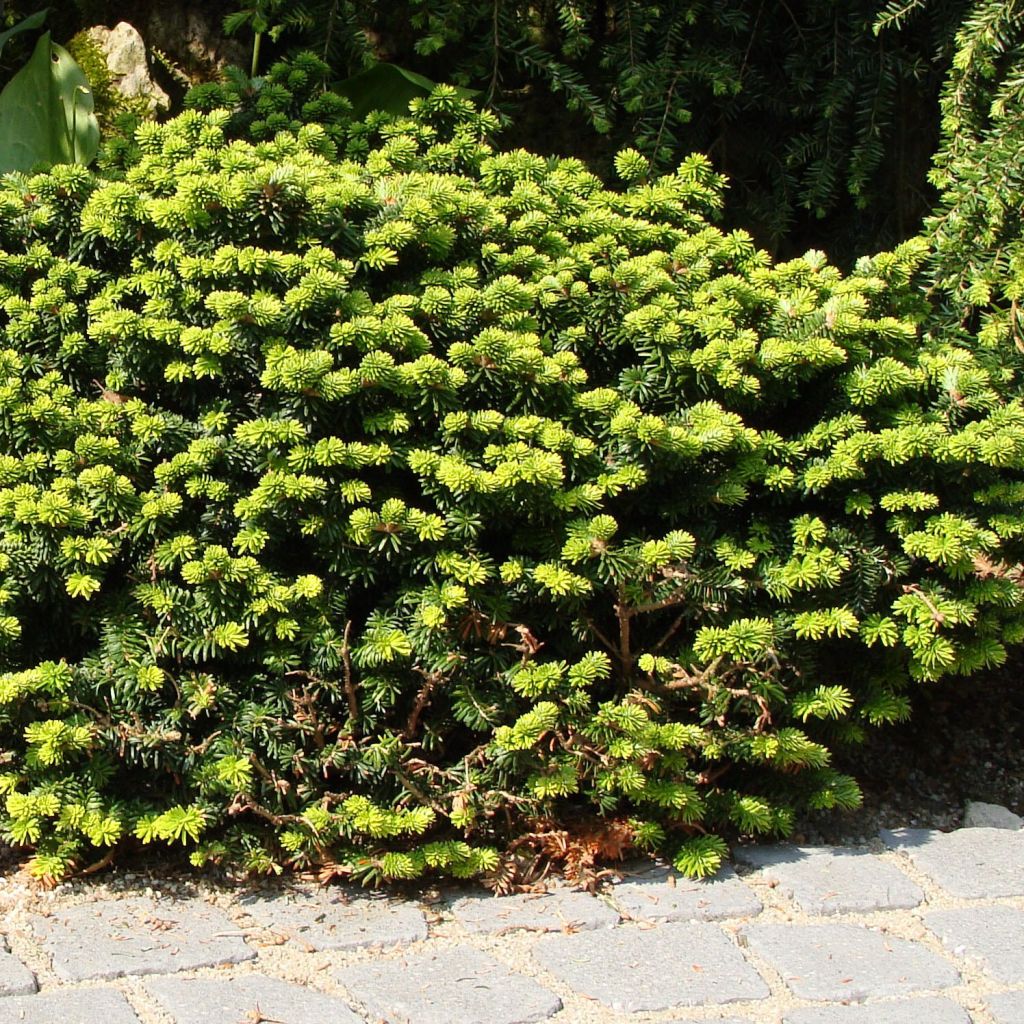

Abies balsamea Nana - Fir
Abies balsamea Nana - Fir
Abies balsamea Nana
Balsam Fir
This item cannot be shipped to the selected country
Delivery charge from €5.90
Delivery charge from €5.90
More information
Schedule delivery date,
and select date in basket
This plant carries a 24 months recovery warranty
More information
We guarantee the quality of our plants for a full growing cycle, and will replace at our expense any plant that fails to recover under normal climatic and planting conditions.
From €5.90 for pickup delivery and €6.90 for home delivery
Express home delivery from €8.90.
From €5.90 for pickup delivery and €6.90 for home delivery
Express home delivery from €8.90.
Does this plant fit my garden?
Set up your Plantfit profile →
Description
Abies balsamea 'Nana' is a dwarf form of balsam fir, with a sturdy and very compact habit, covered in fine and soft, bright green foliage. In spring, its light and prominent buds at the end of almost vertical branches bring light to the whole. With its slow growth and small size, it is perfect for small gardens, rock gardens, or containers.
The balsam fir is a conifer of the Pinaceae family, native to North America, which reaches a height of 15 to 20m (49ft 2in to 65ft 7in) in its natural environment and forms a trunk of 60cm (23.6in) in diameter.
The 'Nana' form represents a kind of miniature of this species. It will not exceed 50cm (19.7in) in height and 65cm (25.6in) in diameter, after many years of cultivation. It has a compact habit, initially globose, then more spreading, and forms a very soft cushion, made up of upright branches where very thin and very flexible, bright green needles are inserted, marked with 2 white lines on the underside. Its large spring buds crown its dark green foliage with a lime green velvet. Note that this variety, like the species, is impregnated with a fragrant resin (a balm) exuding a very pleasant spicy fragrance.
Abies balsamea 'Nana' is ideal for container cultivation on a terrace or in small gardens thanks to its slow growth and small size. With its dense cushion-like silhouette, which does not require pruning, it will work wonders in rock gardens, especially if planted in groups of 3 subjects. The true graphic qualities of dwarf conifers naturally impose themselves in the design of a contemporary garden, which prefers the aesthetics of forms, silhouettes, and textures to that of flowering. These plants with a strong personality structurally enhance a bed, mark the paths, border the terrace, easily replacing the strong presence of trimmed boxwood. They serve as a backdrop for small roses, peonies, or tousled grasses with a very complementary temperament. They can also be associated with ground cover plants such as aubrietas, Cerastiums, and flowering shrubs. The key is to play with volumes and colours.
Report an error about the product description
Abies balsamea Nana - Fir in pictures




Plant habit
Foliage
Botanical data
Abies
balsamea
Nana
Pinaceae
Balsam Fir
Cultivar or hybrid
Other Abies
Planting and care
Plant Abies balsamea 'Nana' from September to November or from February to June, in a regular soil, enriched with humus, not too dry, in full sun or partial shade. Water the young plants regularly during the two to three summers following the planting. The balsam fir can tolerate periods of drought, but it will be necessary to water it during prolonged periods of high heat. This bush does not require pruning, but it is possible to remove any branches that have become unsightly or bothersome.
Planting period
Intended location
Care
-
, onOrder confirmed
Reply from on Promesse de fleurs
Evergreen shrubs
Haven't found what you were looking for?
Hardiness is the lowest winter temperature a plant can endure without suffering serious damage or even dying. However, hardiness is affected by location (a sheltered area, such as a patio), protection (winter cover) and soil type (hardiness is improved by well-drained soil).

Photo Sharing Terms & Conditions
In order to encourage gardeners to interact and share their experiences, Promesse de fleurs offers various media enabling content to be uploaded onto its Site - in particular via the ‘Photo sharing’ module.
The User agrees to refrain from:
- Posting any content that is illegal, prejudicial, insulting, racist, inciteful to hatred, revisionist, contrary to public decency, that infringes on privacy or on the privacy rights of third parties, in particular the publicity rights of persons and goods, intellectual property rights, or the right to privacy.
- Submitting content on behalf of a third party;
- Impersonate the identity of a third party and/or publish any personal information about a third party;
In general, the User undertakes to refrain from any unethical behaviour.
All Content (in particular text, comments, files, images, photos, videos, creative works, etc.), which may be subject to property or intellectual property rights, image or other private rights, shall remain the property of the User, subject to the limited rights granted by the terms of the licence granted by Promesse de fleurs as stated below. Users are at liberty to publish or not to publish such Content on the Site, notably via the ‘Photo Sharing’ facility, and accept that this Content shall be made public and freely accessible, notably on the Internet.
Users further acknowledge, undertake to have ,and guarantee that they hold all necessary rights and permissions to publish such material on the Site, in particular with regard to the legislation in force pertaining to any privacy, property, intellectual property, image, or contractual rights, or rights of any other nature. By publishing such Content on the Site, Users acknowledge accepting full liability as publishers of the Content within the meaning of the law, and grant Promesse de fleurs, free of charge, an inclusive, worldwide licence for the said Content for the entire duration of its publication, including all reproduction, representation, up/downloading, displaying, performing, transmission, and storage rights.
Users also grant permission for their name to be linked to the Content and accept that this link may not always be made available.
By engaging in posting material, Users consent to their Content becoming automatically accessible on the Internet, in particular on other sites and/or blogs and/or web pages of the Promesse de fleurs site, including in particular social pages and the Promesse de fleurs catalogue.
Users may secure the removal of entrusted content free of charge by issuing a simple request via our contact form.
The flowering period indicated on our website applies to countries and regions located in USDA zone 8 (France, the United Kingdom, Ireland, the Netherlands, etc.)
It will vary according to where you live:
- In zones 9 to 10 (Italy, Spain, Greece, etc.), flowering will occur about 2 to 4 weeks earlier.
- In zones 6 to 7 (Germany, Poland, Slovenia, and lower mountainous regions), flowering will be delayed by 2 to 3 weeks.
- In zone 5 (Central Europe, Scandinavia), blooming will be delayed by 3 to 5 weeks.
In temperate climates, pruning of spring-flowering shrubs (forsythia, spireas, etc.) should be done just after flowering.
Pruning of summer-flowering shrubs (Indian Lilac, Perovskia, etc.) can be done in winter or spring.
In cold regions as well as with frost-sensitive plants, avoid pruning too early when severe frosts may still occur.
The planting period indicated on our website applies to countries and regions located in USDA zone 8 (France, United Kingdom, Ireland, Netherlands).
It will vary according to where you live:
- In Mediterranean zones (Marseille, Madrid, Milan, etc.), autumn and winter are the best planting periods.
- In continental zones (Strasbourg, Munich, Vienna, etc.), delay planting by 2 to 3 weeks in spring and bring it forward by 2 to 4 weeks in autumn.
- In mountainous regions (the Alps, Pyrenees, Carpathians, etc.), it is best to plant in late spring (May-June) or late summer (August-September).
The harvesting period indicated on our website applies to countries and regions in USDA zone 8 (France, England, Ireland, the Netherlands).
In colder areas (Scandinavia, Poland, Austria...) fruit and vegetable harvests are likely to be delayed by 3-4 weeks.
In warmer areas (Italy, Spain, Greece, etc.), harvesting will probably take place earlier, depending on weather conditions.
The sowing periods indicated on our website apply to countries and regions within USDA Zone 8 (France, UK, Ireland, Netherlands).
In colder areas (Scandinavia, Poland, Austria...), delay any outdoor sowing by 3-4 weeks, or sow under glass.
In warmer climes (Italy, Spain, Greece, etc.), bring outdoor sowing forward by a few weeks.


































